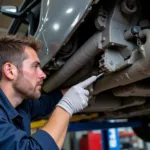Repairing a large hole in your car body can seem daunting, but with the right approach, it’s a manageable task. Whether it’s from rust, a collision, or some other unfortunate incident, this guide will walk you through the steps to fix that unsightly damage and restore your car’s appearance.
Assessing the Damage and Gathering Your Supplies
Before you start, it’s crucial to assess the extent of the damage. A small hole might require a simple patch, while a larger one might necessitate welding in a new piece of metal. This initial assessment will determine the tools and materials you’ll need. For a large hole, you’ll likely need:
- Safety glasses and gloves
- Sandpaper (various grits)
- Metal shears or a cutoff wheel
- Body filler
- A spreader
- Primer
- Paint that matches your car’s color
- Clear coat
- Welding equipment (if necessary)
- Sheet metal (if welding)
Once you’ve gathered your supplies, you’re ready to begin the repair process. It’s important to work in a well-ventilated area and take all necessary safety precautions.
 Assessing the Damage to Car Body Before Repair
Assessing the Damage to Car Body Before Repair
Preparing the Area Around the Hole
Clean the area around the hole thoroughly with a degreaser and then sand down the paint and any rust around the damaged area. You want to create a clean, bare metal surface for the filler to adhere to. Use progressively finer grits of sandpaper to smooth the area. This crucial step ensures a proper repair and prevents future rust.
 Sanding the Damaged Area of Car Body for Repair
Sanding the Damaged Area of Car Body for Repair
Patching the Hole: Welding vs. Body Filler
Depending on the size and location of the hole, you might need to weld in a new piece of sheet metal. If the hole is relatively small and in a non-structural area, you can often use body filler to repair it. For larger holes, especially those on structural components, welding is the preferred method. Remember, safety is paramount. If you’re unsure about welding, consult a professional.
For smaller holes, apply the body filler using a spreader, ensuring it fills the hole completely and overlaps the surrounding metal. Allow the filler to dry and harden according to the manufacturer’s instructions. You might need to apply multiple layers of filler, sanding between each layer to achieve a smooth, even surface. How much does repairing a dent in a car cost? It depends on the extent of the damage.
Sanding, Priming, and Painting
Once the filler is completely dry, sand the repaired area until it’s smooth and flush with the surrounding body panel. Apply a thin coat of primer to the repaired area, allowing it to dry completely. Then, apply several thin coats of paint that matches your car’s color, allowing each coat to dry before applying the next. Finish with a clear coat to protect the paint and give it a glossy finish.
 Painting the Repaired Area of a Car Body
Painting the Repaired Area of a Car Body
Final Touches and Considerations
After the clear coat has dried, inspect the repaired area and polish it if necessary. While this DIY approach can be effective, remember that complex repairs might require the expertise of a professional auto body shop.
John Smith, Certified Auto Body Technician at Smith Auto Repair, advises: “Always prioritize safety when undertaking car body repairs. If you’re unsure about any step, it’s best to consult a professional.”
Maria Garcia, Lead Mechanic at Garcia’s Auto Services, adds: “Proper preparation is key to a successful car body repair. Ensure the area is clean and free of rust before applying any filler or paint.”
In conclusion, repairing a large hole in your car body requires patience, the right tools, and a methodical approach. By following these steps, you can effectively address the damage and restore your car’s appearance. Remember to always prioritize safety and consult a professional if needed. How much does repairing a dent in a car cost if you’re not comfortable doing it yourself? It’s worth checking with a local auto body shop for a quote.
FAQ
- Can I repair a large hole in a structural area myself? While possible, it’s recommended to consult a professional for structural repairs to ensure the integrity of your vehicle.
- What type of body filler should I use? Use a high-quality body filler designed for automotive applications.
- How long does it take for body filler to dry? Drying time varies depending on the product and ambient temperature. Always follow the manufacturer’s instructions.
- Do I need to use primer before painting? Yes, primer is essential for proper paint adhesion and durability.
- Can I use spray paint for this repair? While possible, using an automotive paint gun will provide a more professional and even finish.
- What if the rust returns after the repair? This indicates the rust wasn’t completely removed before the repair. You may need to start the process again, ensuring all rust is eliminated.
- How can I prevent future rust? Regularly washing and waxing your car can help protect against rust.
For more detailed information on dent repair costs, you can visit our page on how much does repairing a dent in a car cost.
Need further assistance? Don’t hesitate to contact us via WhatsApp: +1(641)206-8880, or Email: [email protected]. Our customer service team is available 24/7 to assist you.


